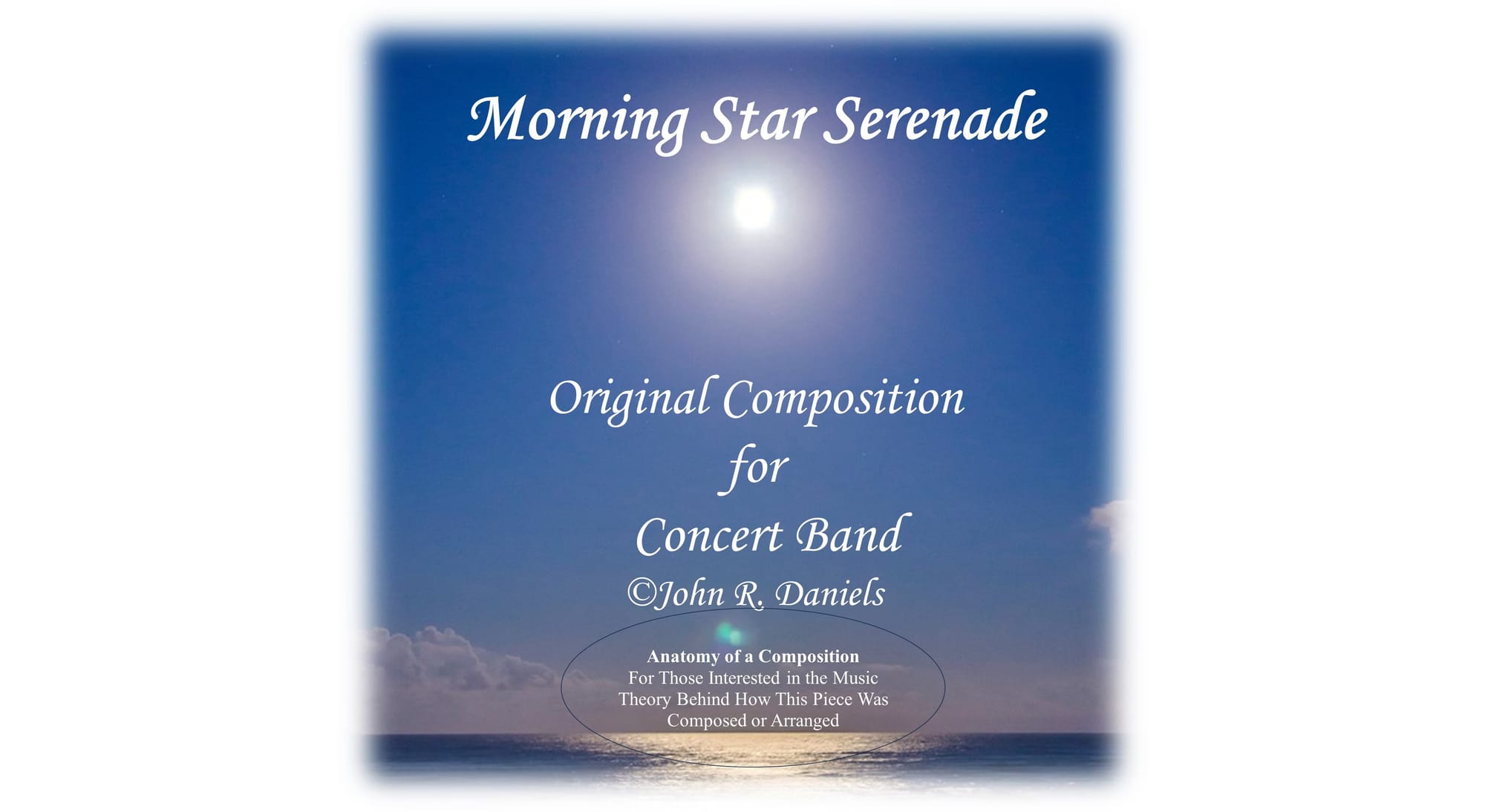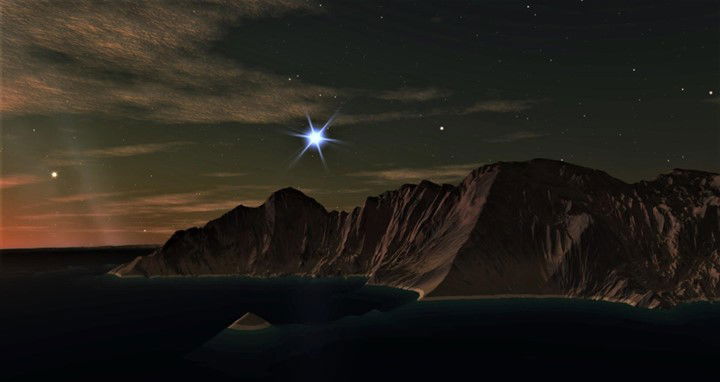Anatomy of a Composition - Morning Star Serenade for Concert Band

The “Anatomy of a Composition” series of articles is for anyone interested in the composition process, or for Music Theory teachers and students. These articles will supply enough information to understand the basic elements of the song, while allowing for independent study of the particulars of each element. If more information is needed, please Contact Us. We’re always glad to help people learn about composing and arranging.
This article contains some technical music theory terms. If you need help remembering a term or two, there is a glossary of terms at the end. There may be more definitions than you need.

Here are a few thoughts on composing in general. Composing is a multifaceted endeavor. It starts with thinking of a few motifs, a theme or two and a form. The real tricky part is thinking of something that hasn’t been done before. There have been more than a few times that I committed something to paper (so to speak, since 98% of my writing these days is done on the computer) and found out that it wasn’t entirely original. Just for fun, here are a few examples:
* I wrote a song in college that I was sure was original. The only thing is that we had just finished studying Pachelbel’s Canon in D, and I had just recently been listening to One Tin Soldier a popular song of the day. The song was for theory class, and I got an A, but several months later it hit me. I had really only fused a couple of songs. I later transcribed it for String Orchestra. It’s called “Jewels and Treasures”. Check it out HERE.

* In a Christmas cantata that I wrote for children called Christmas Word, I borrowed from the chord progression for Hotel California by The eagles for the middle section. See the Sample above. Here’s the original demo of The Word. It’s in my plans to re-record the demo because this isn’t so great. (If you know of anyone that has access to an older children’s choir (ages 10 – 14) and would like to have this musical in exchange for recording it for me, please Contact Us for details.)

* In the same Christmas cantata, I borrowed a few musical devices from Bach and others. The two main ideas for the cantata was to incorporate Scripture (sometimes modified to better fit the music) with new classical music. It was inspired by Handel’s Messiah. The most notable example is at the end of the piece mentioned above, The Word where I used a disjunct spelling of a I – V – I progression. See sample above.

HISTORY AND NAME: This time we’ll be looking at Morning Star Serenade, an original composition for Concert Band.
As far as the name goes, many times I’ll have an idea about what the song will sound like and what it should be called. This time, however, I used a working title until I was finished. Then, as I listened to it, I had a picture develop in my mind that required a good title. After a few false starts, I settled on Morning Star Serenade because not only did the whole piece sound like the rising of the Morning Star, but it seems to happen a number of times throughout the piece. Jesus calls Himself the Morning Star in the book of Revelation.
Click HERE to go to the Salt Cellar web page with info about “Morning Star Serenade”. There, you’ll find links to the YouTube video, print sample and purchase option.
KEY CHOICE: I chose the key of B flat major for a number of reasons:
- It’s among the easiest to play
- There are a number of other challenges that would be more difficult in another key, including trills and triplets.
- That key keeps the tessitura as high as possible for most instruments without becoming too difficult to play. The whole mood of the song needed to be able to be expressed with a wide climb of notes.
TIME SIGNATURE CHOICE: The 4/4 time signature can be played at a great number of tempos. While I chose 4/4 for this piece, I also had a particular tempo range in mind, one that evoked a feeling of not only a royal occasion, but a majestic sight as well.

FORM, CHORD STRUCTURE AND DESCRIPTION: Here’s a basic description of the creative process that went on in my mind.
First, I let my mind wander over a couple dozen different motifs and themes. I didn’t actively differentiate between the two elements; this was a clearly creative, brainstorming process. When I had discovered something that I was fairly sure wasn’t a complete plagiarism, I wrote it down as a trumpet section feature. What resulted from this creative activity was a relatively simple A and B section, a main melody and a companion melody. I had to decide on a “basic’ chord progression for each of them and marked them in. Then I added some harmony to it that strictly, and simply fit those chords.
I have a very active mind, so the first “draft” of Morning Star Serenade included a lot of motion and ornamentations. After reviewing it, I decided that it was too fancy for the beginning of the piece. However, I had no immediate idea what to do with it.
Its form is a simple AB form with some variations on how they are presented.
I am a fan of alternate chord progressions, so I combined two musical devices and made a rough outline of the piece.
- The first device is the use of alternate chords. They are fairly simple at the beginning and progress toward more “interesting” as the piece goes on. For the primary melody, the first is I, V, flat VII, IV (Bb, F, Ab, Eb). There’s one progression in the middle that goes I, flat VII, IV, IVm. There are also some breath-taking chord changes that aren’t found on many theory books. They aren’t quite jazz, but they are quite fresh.
- The second device is alternate accompaniments. These range from broken chords to trumpet fanfares. Some accompaniment parts consist of two or more instruments, or groups of instruments, playing complimentary eighth note arpeggios; one plays 4 eighth notes and a half note, while the second plays a half note and the four eighth notes. It gives the impression of an unbroken series of arpeggios while allowing for plenty of breathing room for the younger musicians.

SECRET(S) AND SPECIAL PLACES IN IT:
There aren’t any real secrets in this piece. In others, I’ve hidden chord progressions for other songs, inverted and retrograde material to satisfy my affection for classical structure, and other structural abnormalities.
In measures 41-48, there is a bit of quasi-fugal activity in the woodwinds; it’s somewhat melodic but mostly rhythmic in nature. In measures 56 and 57, there is one of those catch-your-breath type of chord changes. The progression is already a variation of the original, but this part makes it even more note-worthy. (Pun intended)
There is one secret that I suppose I should share. Some of my work is more inspired by a creative process. In this piece, I used a lot more academic techniques to achieve the creative end.
If you are a Concert Band director, I hope that you will purchase Morning Star Serenade for your band’s next concert. If you are a theory teacher, Morning Star Serenade contains a lot of great analysis elements for your classes.
Salt Cellar Creations has a growing library of original works and arrangements that not only sound great when you ensemble plays them, but are equally suited to music theory analysis. Find out more about the available music Salt Cellar Creations HERE.
SCC can also compose an original piece for you or do a custom arrangement for you. There are two ways that this can be done; one is much more affordable than the other. And SCC is always looking for ideas of pieces to arrange or suggestions for original pieces.
We have sold music not only in the US but in Canada, the United Kingdom, France, Australia, New Zealand and Austria. Please visit the WEBSITE or CONTACT US to let us know what we can do for you!
